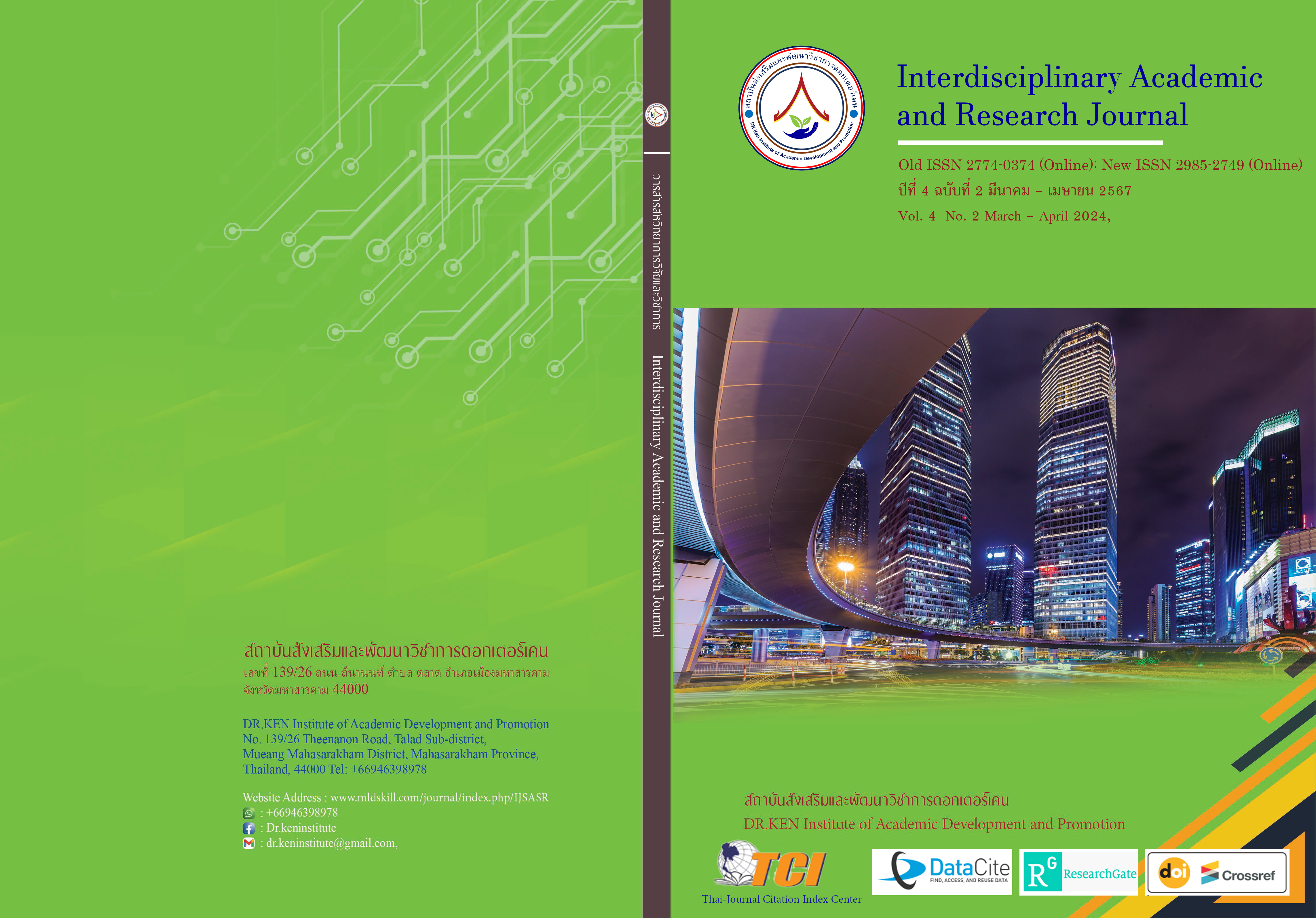Analysis and Management of Carbon Footprint in Production Warehouse Operations
DOI:
https://doi.org/10.60027/iarj.2024.274695Keywords:
Carbon Footprint; , Production Warehouse;, Greenhouse GasesAbstract
Background and Aims: This research focuses on the analysis and management of the carbon footprint in production warehouses within the automotive and auto parts industry in Chonburi Province, Thailand, a critical area significantly impacting greenhouse gas emissions in the country. The primary objectives of this study are 1. To investigate the factors influencing carbon footprint emissions in the warehouses of the automotive and auto parts industry in Chonburi Province. 2. To analyze the greenhouse gas emissions and the amount of carbon footprint resulting from various activities in the production warehouses. 3. To propose appropriate management strategies in the warehouse activities of the automotive and auto parts industry to reduce carbon footprint emissions. The outcomes of this research are vital in supporting sustainable operations and reducing environmental impacts in the activities of production warehouses..
Methodology: This study employed a mixed-methods approach, integrating both qualitative and quantitative research methods, to examine the impact of warehouse activities on carbon footprint. The methodology included (1) Combination of Qualitative and Quantitative Research: Utilizing in-depth interviews to gather qualitative data, followed by the analysis of quantitative data from assessment forms. This approach was aimed at analyzing greenhouse gas emissions and the carbon footprint resulting from warehouse activities. (2) Selection of Population and Sample: The study included a total of 17 participants, comprising warehouse operators, academics, and experts in carbon footprint measurement, to ensure a comprehensive and expert perspective. (3) Research Tools: Development of both qualitative and quantitative research tools, with an emphasis on verifying the accuracy and validity of these tools. (4) Verification of Accuracy and Validity: Preliminary testing was conducted to assess the understandability and appropriateness of the research tools, followed by the evaluation of their reliability and validity. (5) Data Collection: Data was collected through in-depth interviews and quantitative analysis from assessment forms. (6) Data Analysis: Employed qualitative analysis and quantitative data evaluation to meet the third objective of the research. (7) Integration of Results: This involved combining data from both qualitative and quantitative approaches to present suitable management strategies in warehouse activities of the automotive and automotive parts industry to reduce carbon footprint emissions.
Results: This study explores various factors affecting carbon footprint emissions in production warehouse operations, as well as analyzing and evaluating the impacts of various warehouse activities. on greenhouse gas emissions. The findings focused on identifying the activities with the most emissions. It was found that receiving and storing goods were the two main activities that had the greatest impact.
Conclusion: This research proposes new approaches to managing and reducing carbon footprint in warehouses. Focusing on managing and improving operational processes, such as the use of renewable energy and the deployment of automation, reduces energy consumption and greenhouse gas emissions. The proposed approach strengthens environmental sustainability and benefits long-term production warehouse operations.
References
Braun, V., & Clarke, V. (2006). Using thematic analysis in psychology. Qualitative Research in Psychology, 3(2), 77-101.
Brown, L. & Smith, J. (2023). Green logistics: Improving the environmental sustainability of logistics. Kogan Page.
Brown, L. & White, S. (2023). Innovations in warehouse management. John Wiley & Sons.
Bryman, A. (2016). Social research methods. 5th ed. Oxford University Press.
Cook, D.A., & Beckman, T.J. (2006). Current concepts in validity and reliability for psychometric instruments: Theory and application. The American Journal of Medicine, 119(2), 166.e7-166.e16.
Creswell, J. W. (2014). Research design: Qualitative, quantitative, and mixed methods approaches. 4th edition. SAGE Publications.
Creswell, J. W., & Plano Clark, V. L. (2017). Designing and conducting mixed methods research. Sage publications.
Department of Industrial Works. (2022). Industrial statistics and environmental impact in Chonburi. Ministry of Industry, Thailand.
Fink, A. (2017). How to conduct surveys: A step-by-step guide. 6th edition. SAGE Publications
Galli, A., Wiedmann, T., Ercin, E., Knoblauch, D., Ewing, B., & Giljum, S. (2012). Integrating Ecological, Carbon and Water Footprint: Defining the “Footprint Family” and its Application in Tracking Human Pressure on the Planet. Ecological Indicators, 16, 100-112.
Green, T. & Harris, P. (2022). Innovations in logistics and supply chain management technologies for dynamic economies. IGI Global.
Intergovernmental Panel on Climate Change. (2022). Climate Change 2022: Impacts, Adaptation and Vulnerability. IPCC
IPCC. (2013). Guidelines for National Greenhouse Gas Inventories, Volume 2: Energy. Retrieved from https://www.ipcc-nggip.iges.or.jp/public/2006gl/vol2.html.
IPCC. (2014). Climate change 2014: Synthesis report. Cambridge University Press.
Johnson, M. (2020). Carbon footprint management and its importance in sustainability. Environmental Science and Technology, 54(4), 252-259.
Kembro, J. (2018). Efficiency in logistics and warehouse operations. International Journal of Logistics Management, 29(2), 659-678.
Lee, K. (2018). Environmental policies and sustainability in the industrial sector. Journal of Environmental Management, 112, 213-219.
Miles, M.B., Huberman, A.M., & Saldana, J. (2014). Qualitative data analysis: A methods sourcebook. SAGE Publications.
Miller, R. & Jones, D. (2021). Sustainable logistics and supply chain management. Springer.
Moser, A., & Korstjens, I. (2018). Series: Practical guidance to qualitative research. Part 3: Sampling, data collection and analysis. European Journal of General Practice, 24(1), 9-18.
Patel, R. (2019). Sustainable packaging and its environmental impact. Packaging Technology and Science, 32(7), 345-354.
Patton, M.Q. (2015). Qualitative research & evaluation methods: Integrating theory and practice. 4th edition. SAGE Publications.
Ries, J., Grosse, E.H., & Fichtinger, J. (2017). Sustainable environmental practices in logistics and supply chain management. Journal of Cleaner Production, 153, 342-354.
Smith, A. & Johnson, B. (2022). Renewable energy in logistics and supply chain management. Elsevier.
Smith, J., Thompson, L., & Davis, A. (2022). Measuring the carbon footprint in warehouses: A comprehensive approach. Journal of Environmental Management and Operations, 14(3), 45-60.
Staudt, A., Alpan, G., Di Mascolo, M., & Taboada Rodriguez, A. (2015). Warehouse operations and their impact on the carbon footprint. Journal of Industrial Ecology, 19(3), 456-469.
Tavakol, M., & Dennick, R. (2011). Making sense of Cronbach’s alpha. International Journal of Medical Education, 2, 53-55.
Teddlie, C., & Tashakkori, A. (2009). Foundations of mixed methods research: Integrating quantitative and qualitative approaches in the social and behavioral sciences. SAGE Publications.
Thai National LCI Database, TIISMTEC-NSTDA. (2018). Electricity, grid. Retrieved from https://www.tiismtec-nstda.org/thai-national-lci-database.
Thai National LCI Database, TIIS-MTEC-NSTDA. (2019). Paper production and water treatment emission factors. Retrieved from https://www.tiismtec-nstda.org/thai-national-lci-database.
Thai National LCI Database, TIIS-MTEC-NSTDA. (2019). Tap water production from surface water. Retrieved from https://www.tiismtec-nstda.org/thai-national-lci-database.
Turner, K., Lenzen, M., Wiedmann, T., & Barrett, J. (2012). Examining the global environmental impact of regional consumption activities – Part 2: Review of input–output models for the assessment of environmental impacts embodied in trade. Ecological Economics, 61(1), 15-26.
United Nations Environment Programme. (2023). Global greenhouse gas emissions in 2022. Nairobi, Kenya: United Nations Environment Programme.
Van Teijlingen, E., & Hundley, V. (2001). The importance of pilot studies. Social Research Update, 35, 1-4.
Wiedmann, T., & Minx, J. (2008). A Definition of 'Carbon Footprint'. Ecological Economics Research Trends, 1-11.
World Bank. (2023). Carbon dioxide emissions (metric tons per capita). Washington, DC, USA: World Bank.
Downloads
Published
How to Cite
Issue
Section
License
Copyright (c) 2024 Interdisciplinary Academic and Research Journal

This work is licensed under a Creative Commons Attribution-NonCommercial-NoDerivatives 4.0 International License.
Copyright on any article in the Interdisciplinary Academic and Research Journal is retained by the author(s) under the under the Creative Commons Attribution-NonCommercial-NoDerivatives 4.0 International License. Permission to use text, content, images, etc. of publication. Any user to read, download, copy, distribute, print, search, or link to the full texts of articles, crawl them for indexing, pass them as data to software, or use them for any other lawful purpose. But do not use it for commercial use or with the intent to benefit any business.














.png)

